
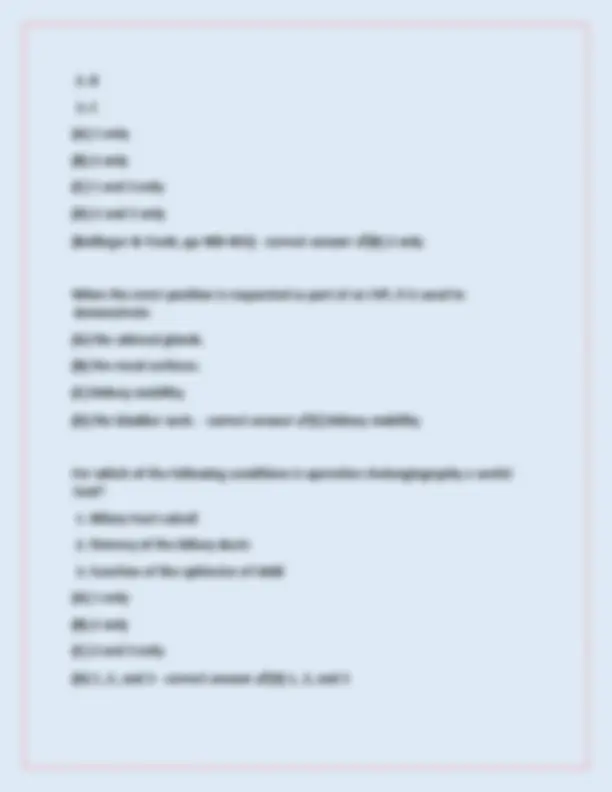


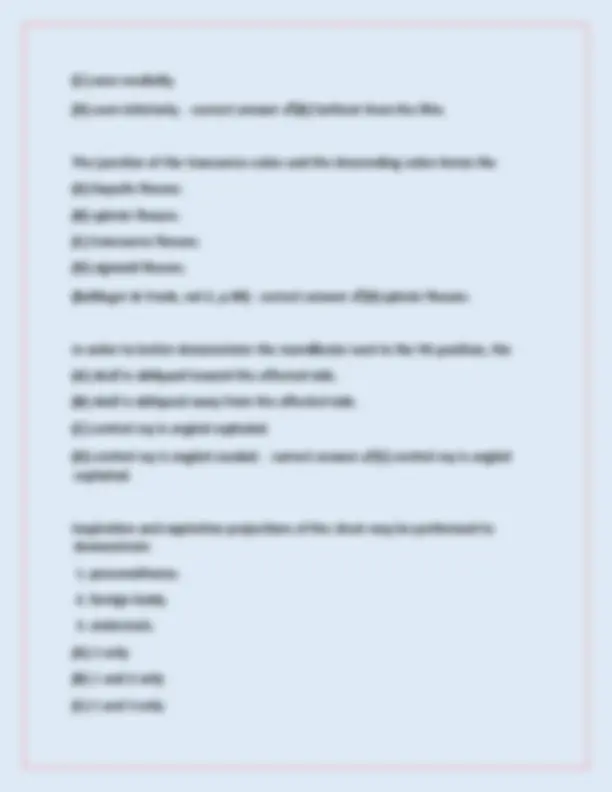
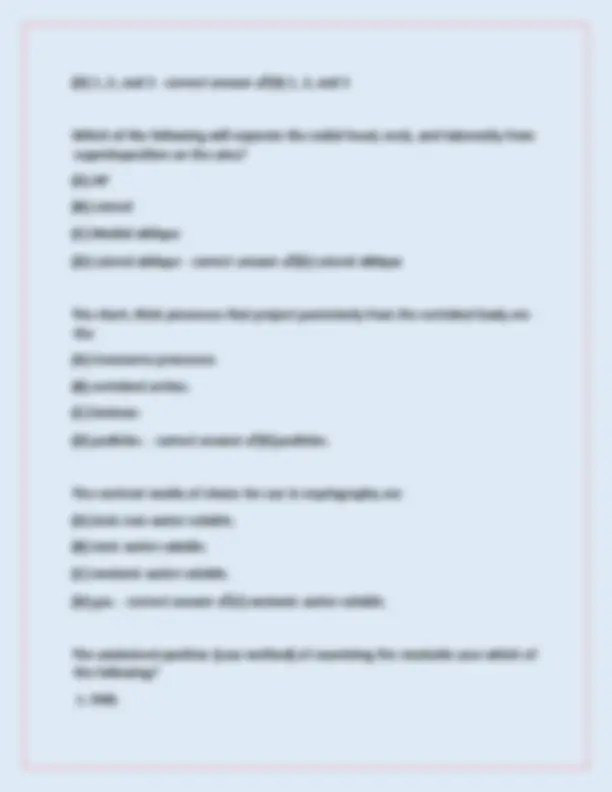
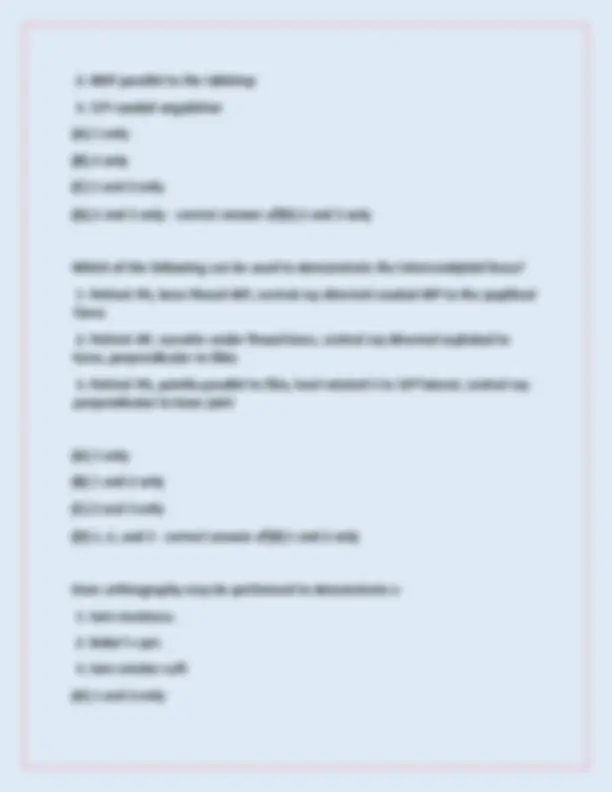
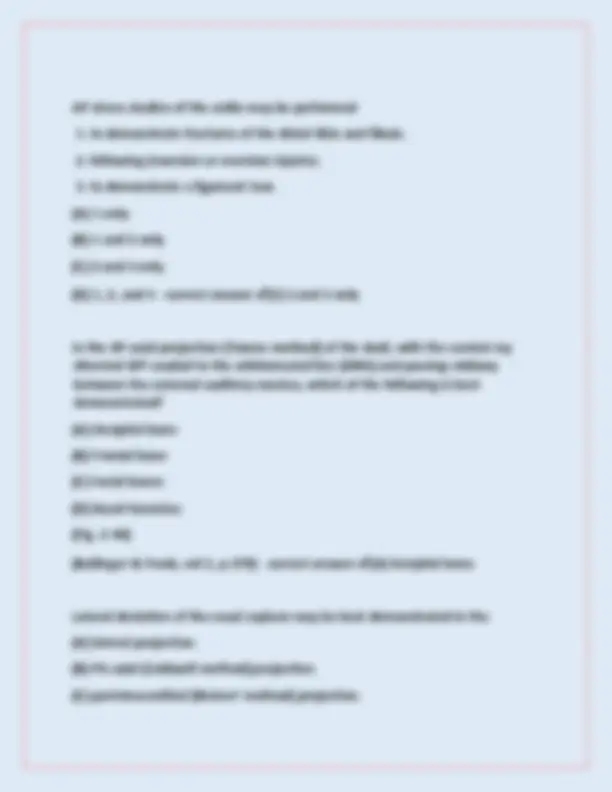

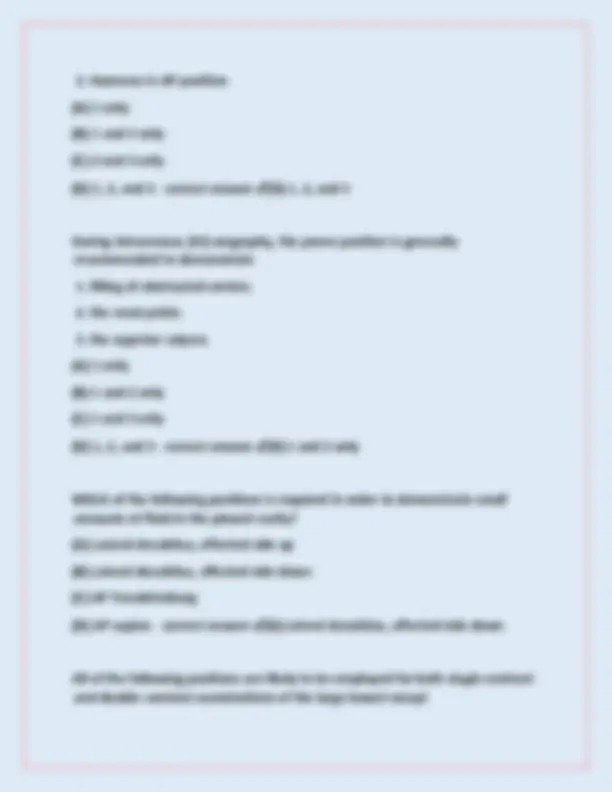


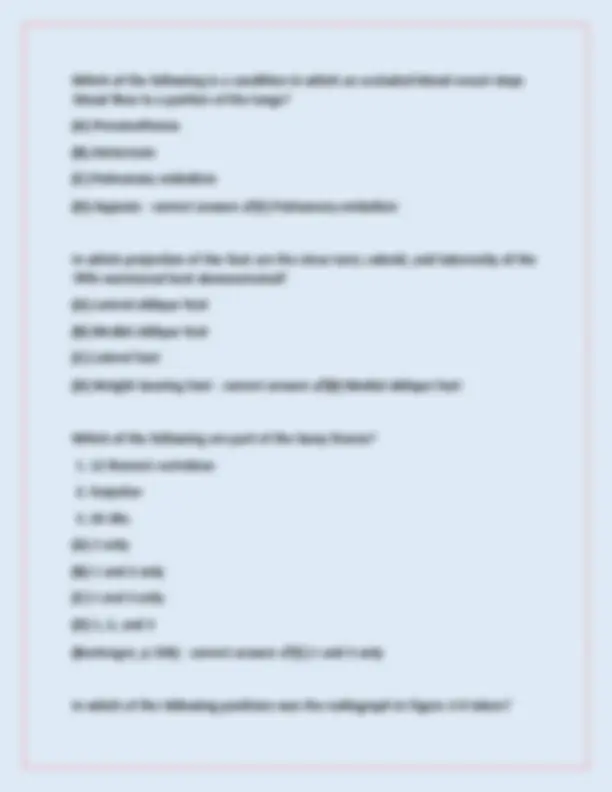


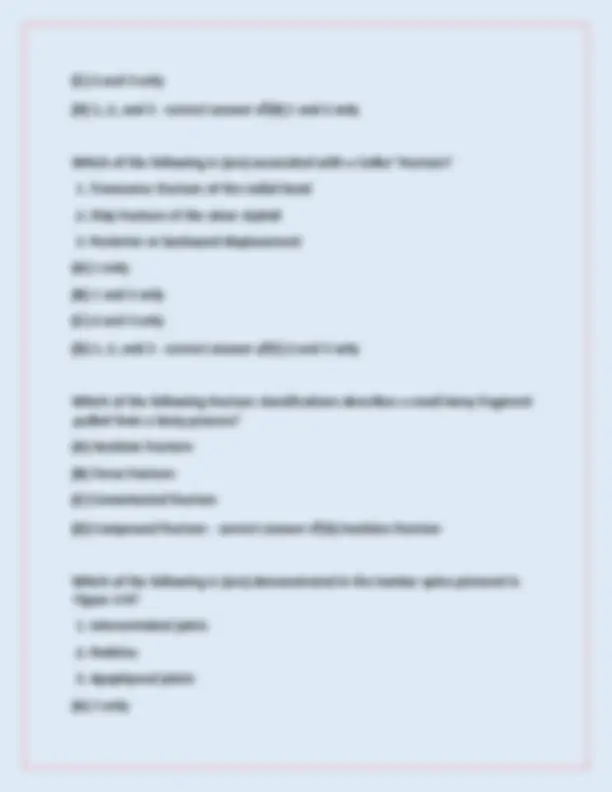

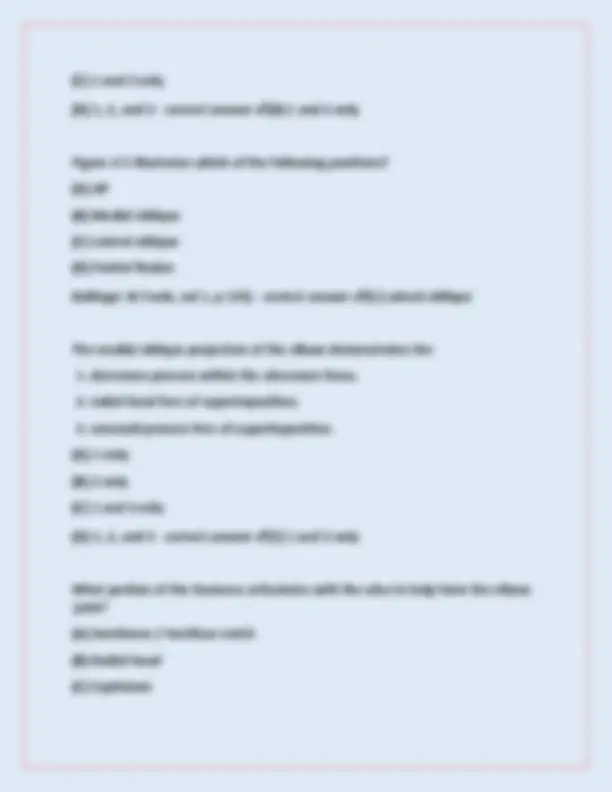

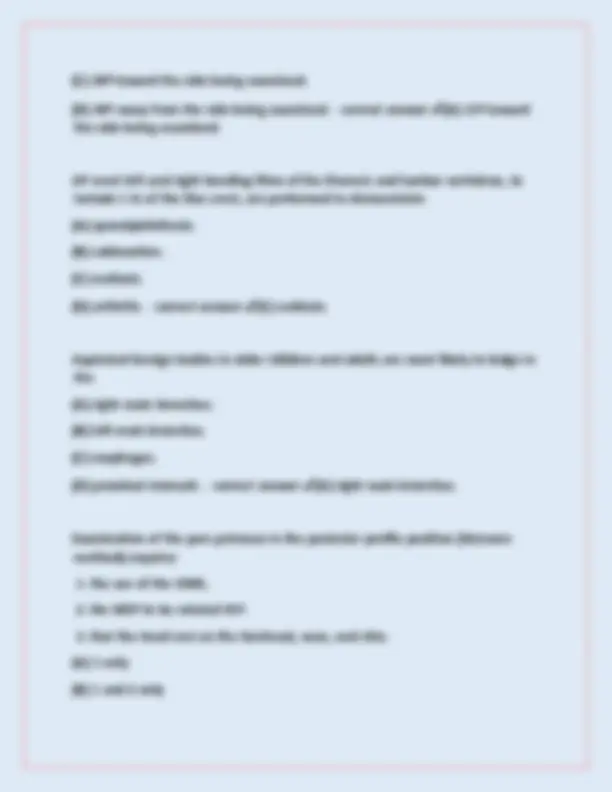
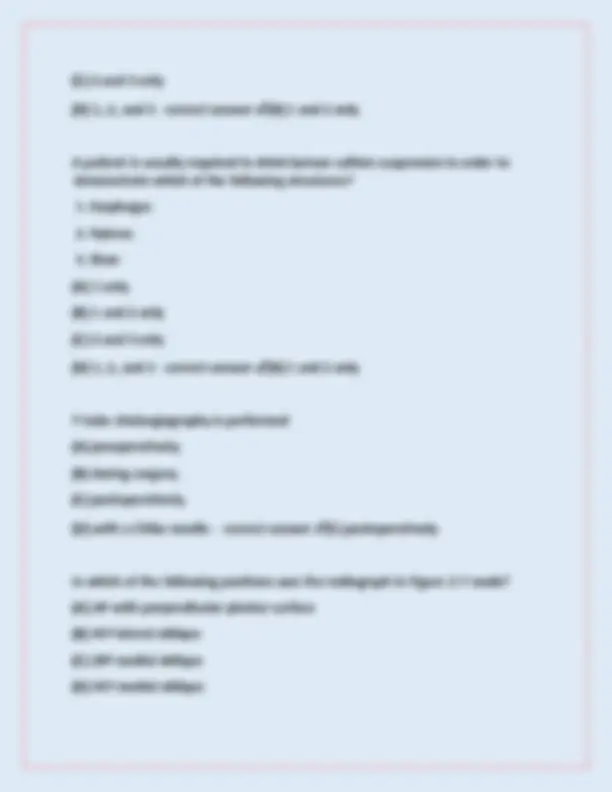
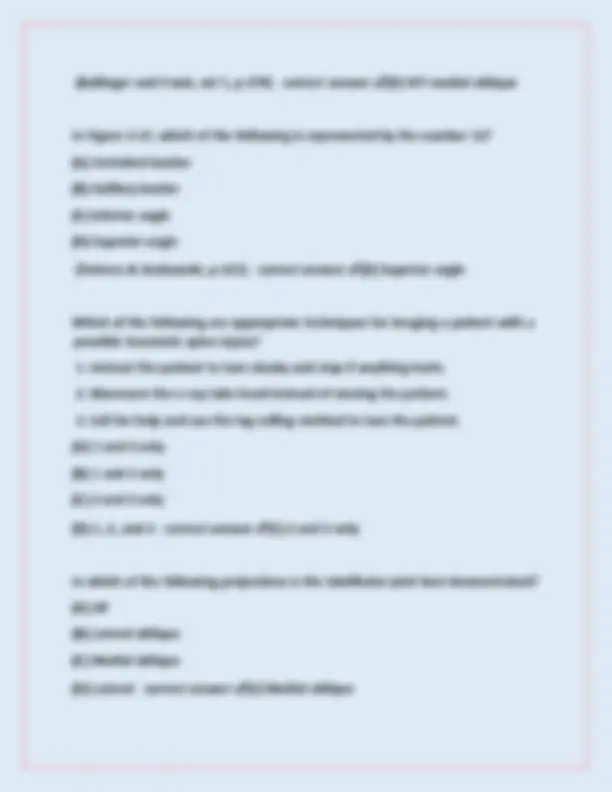


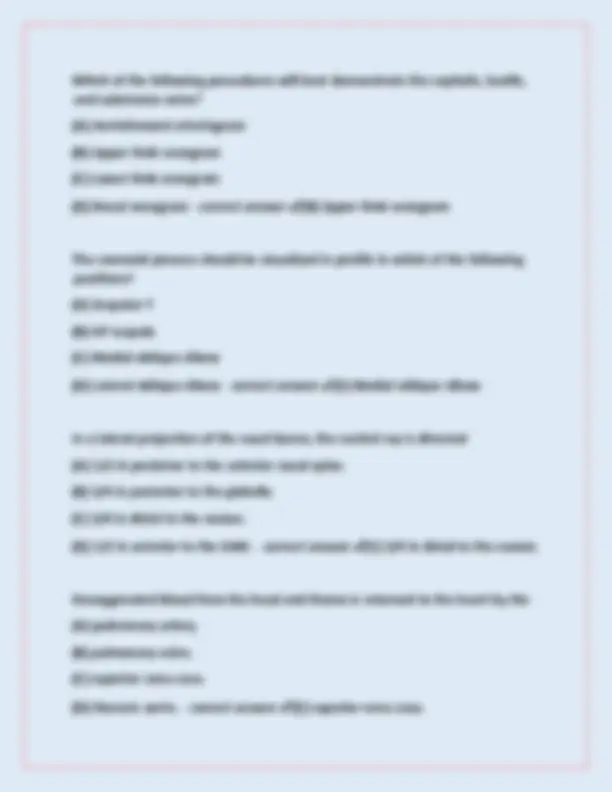
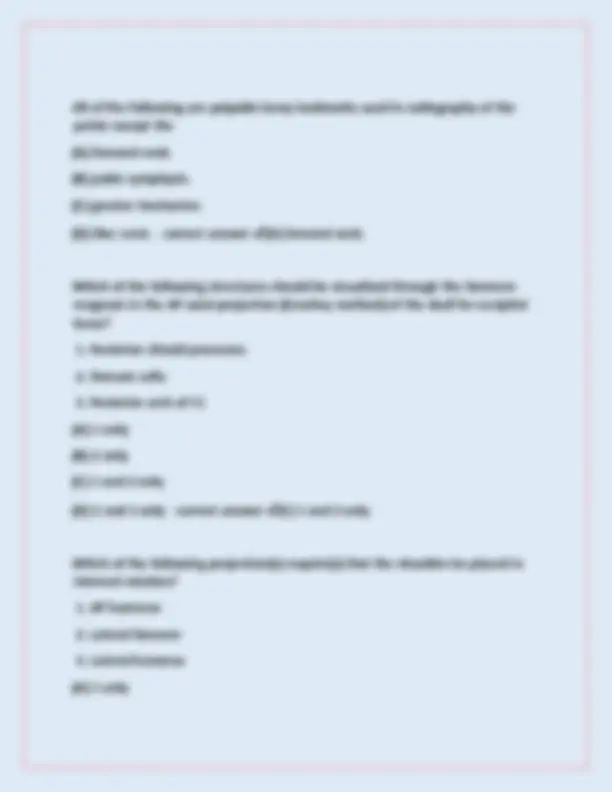
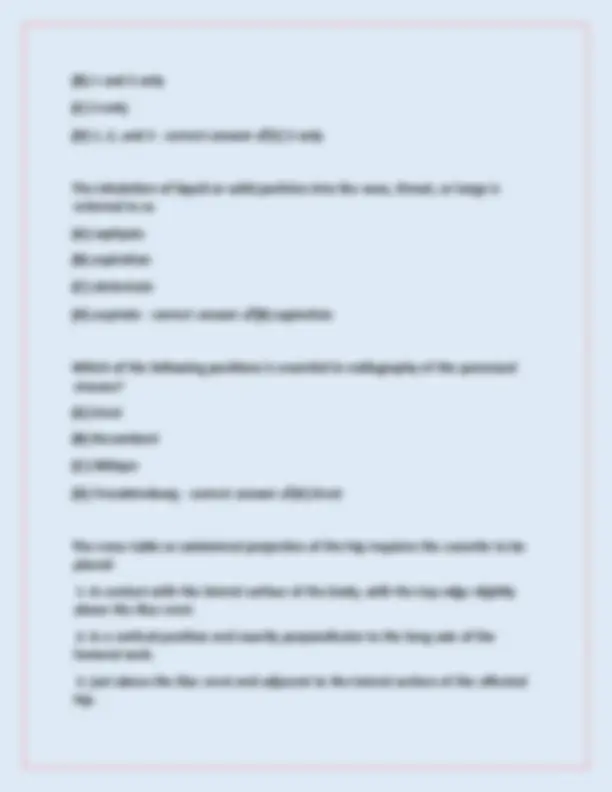
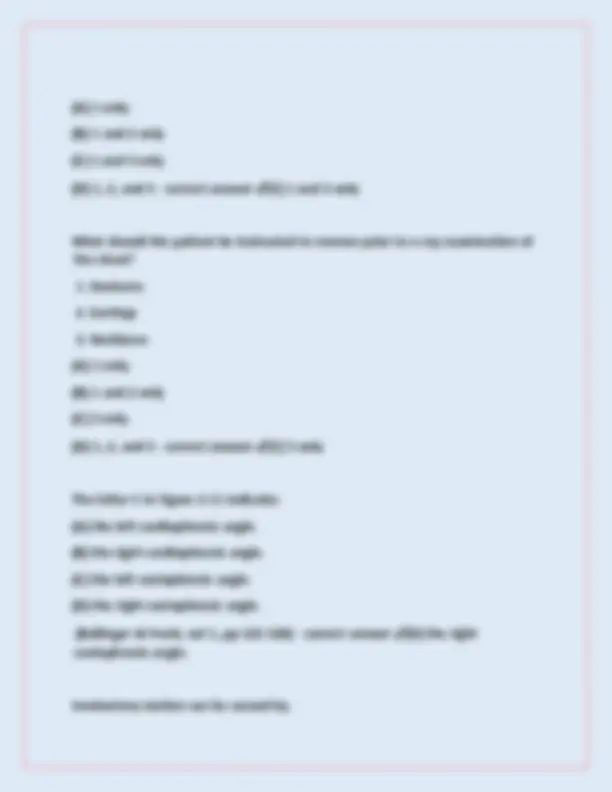
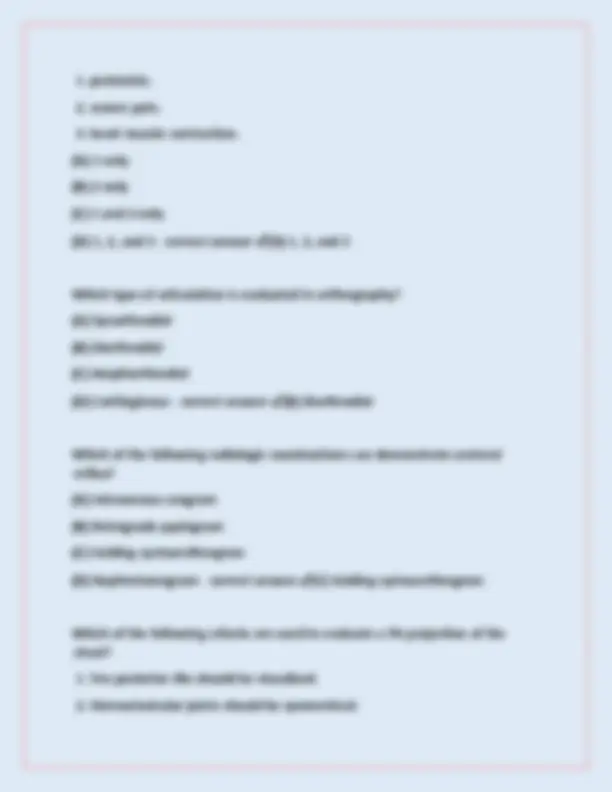
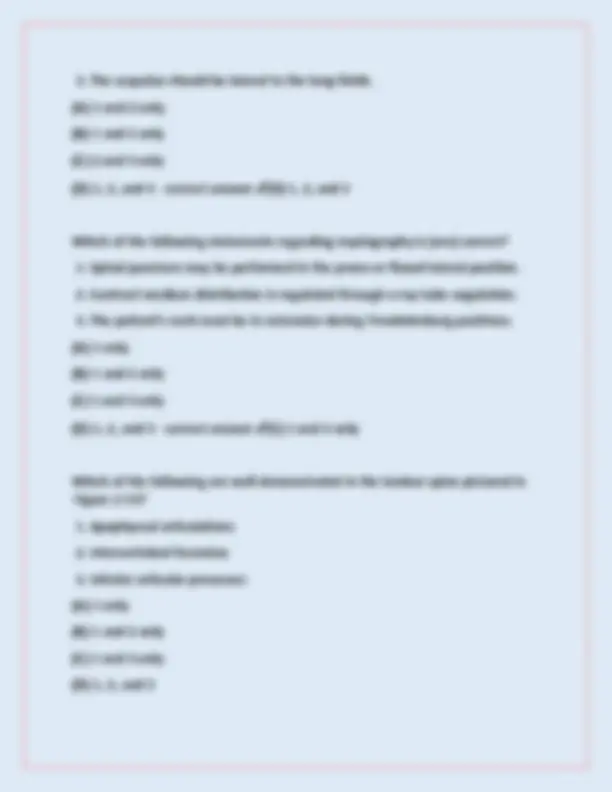
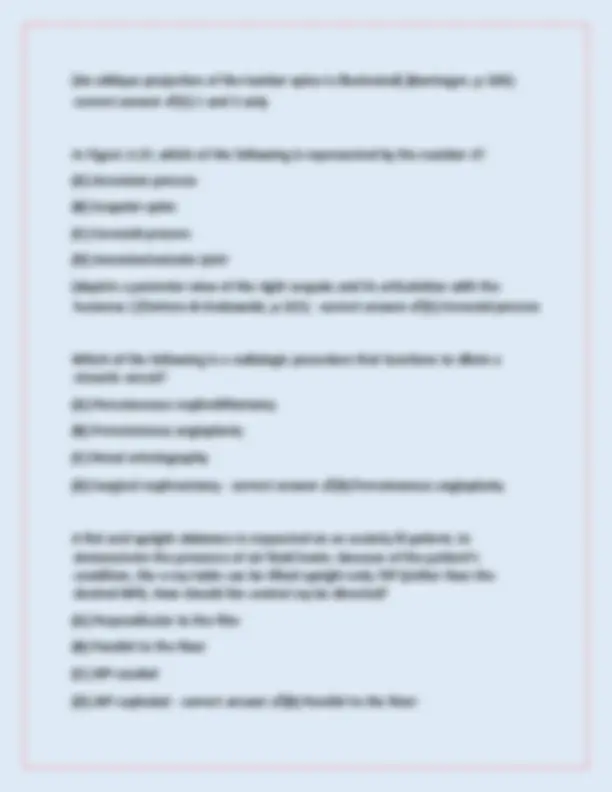
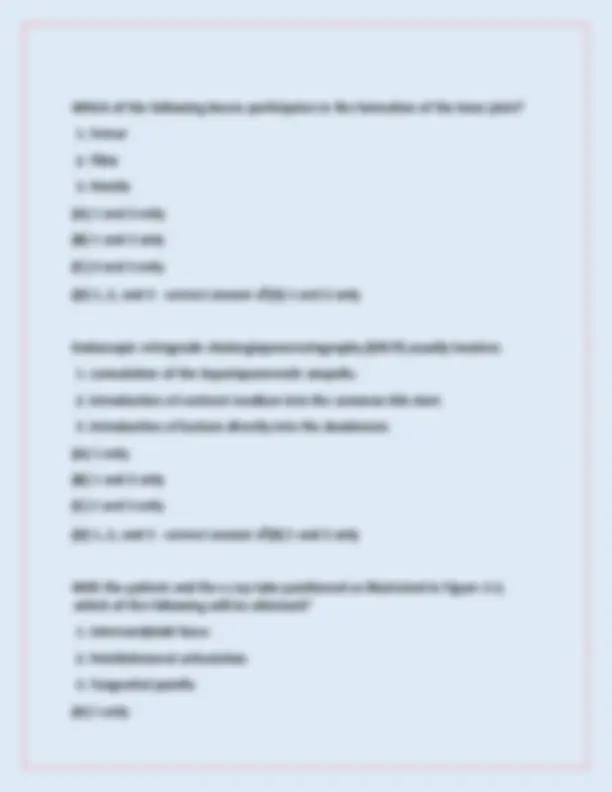
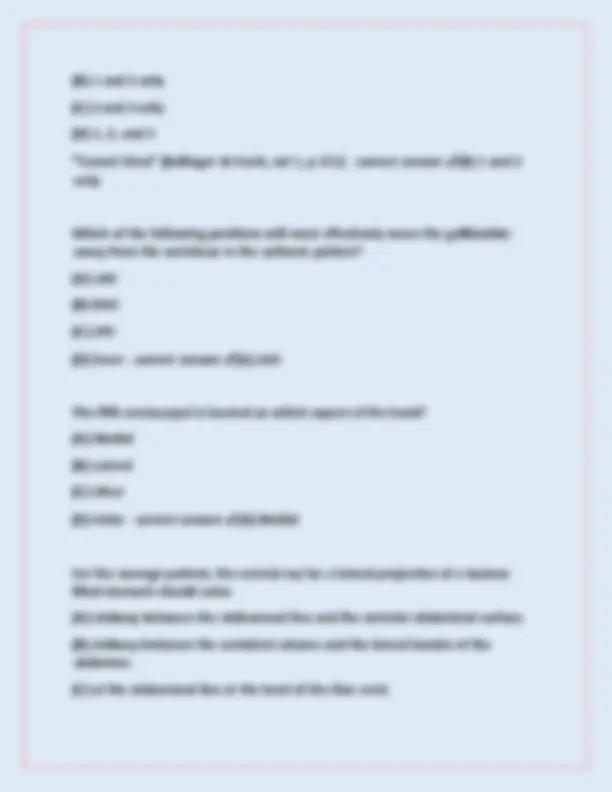
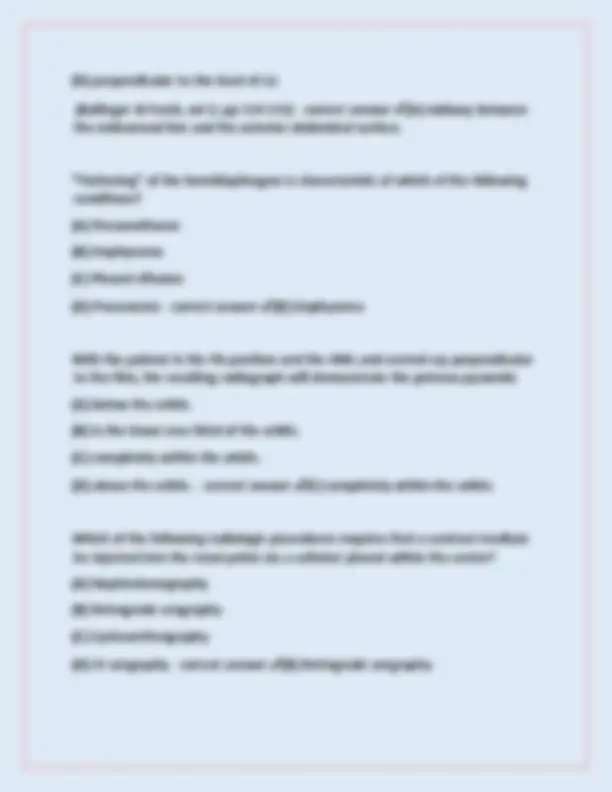

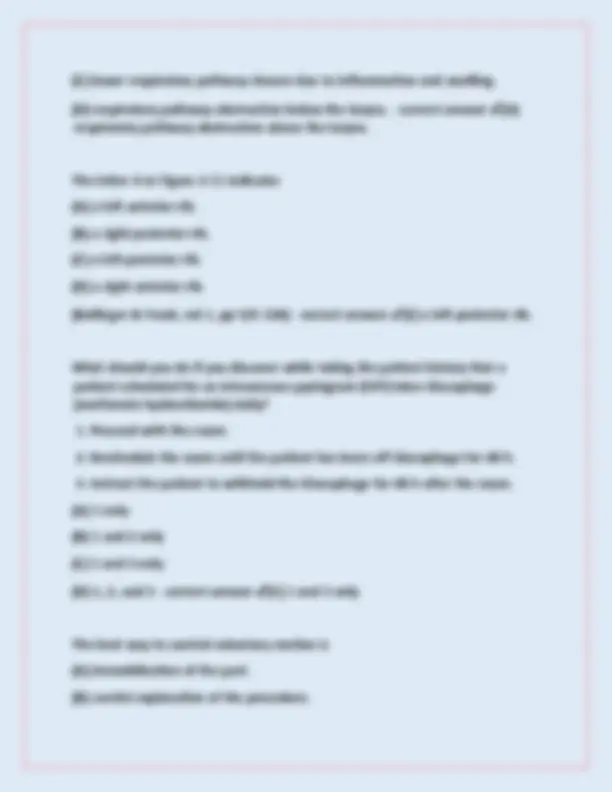
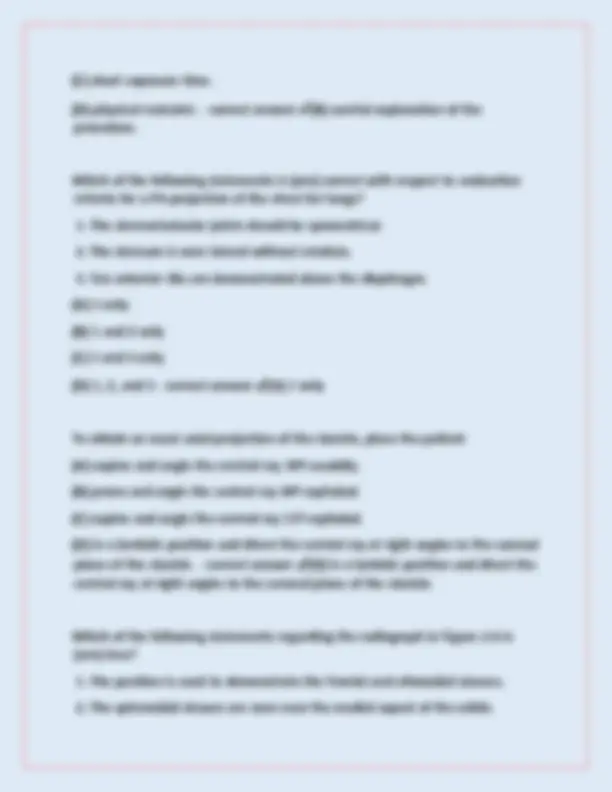
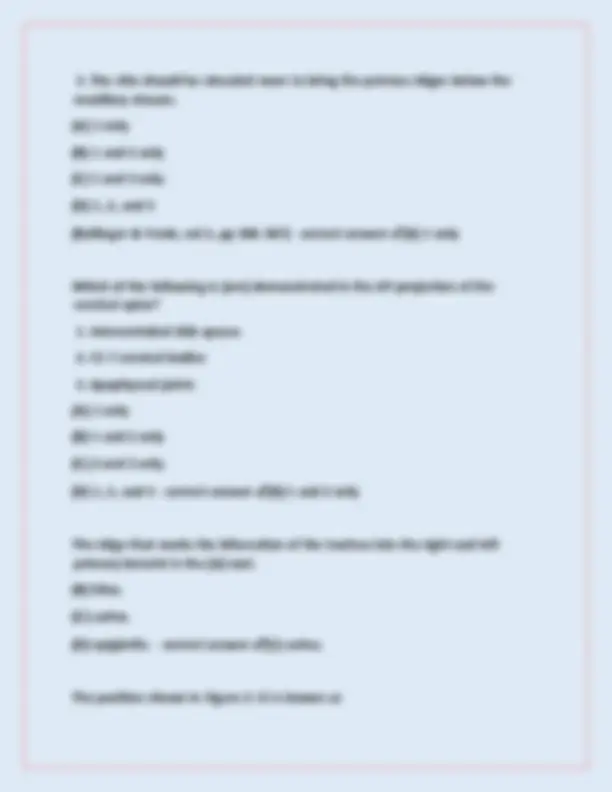
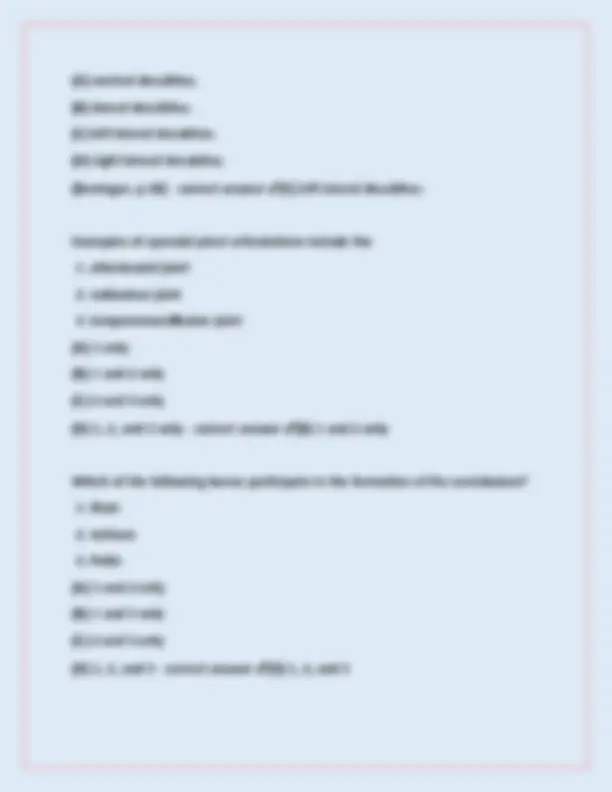
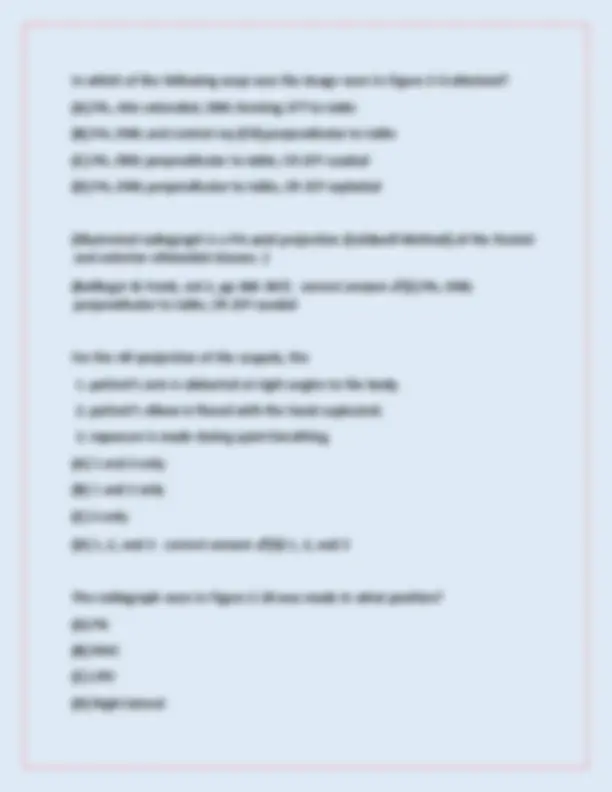
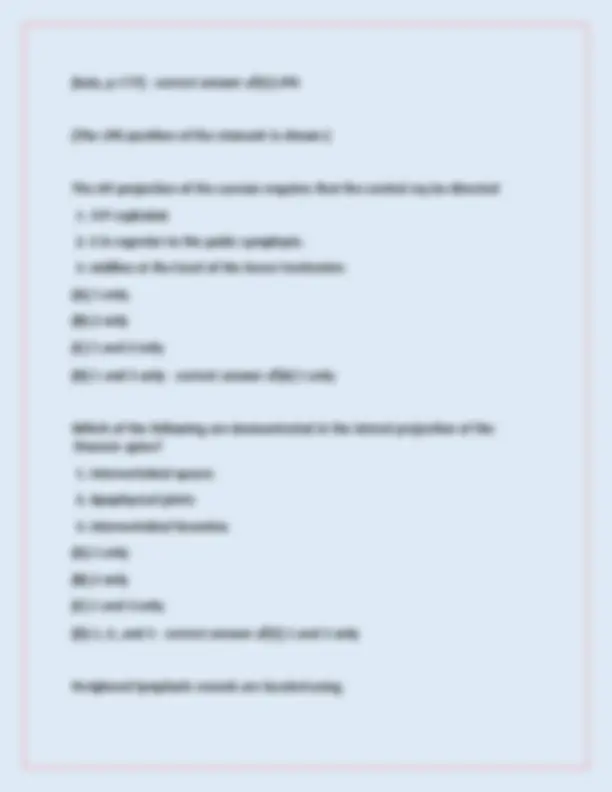
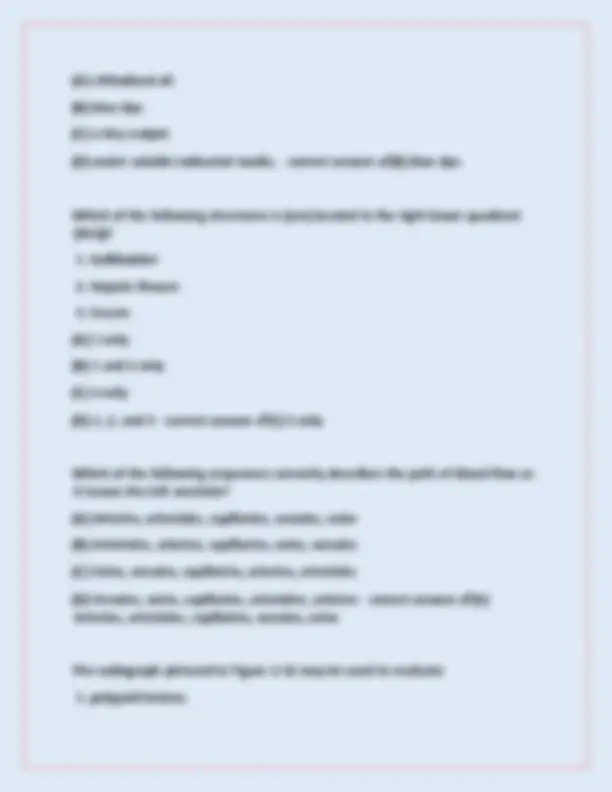
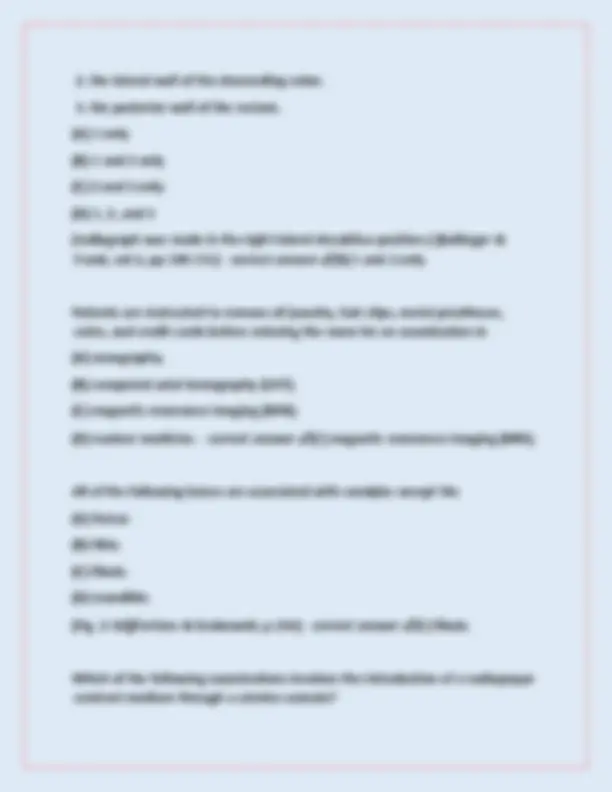
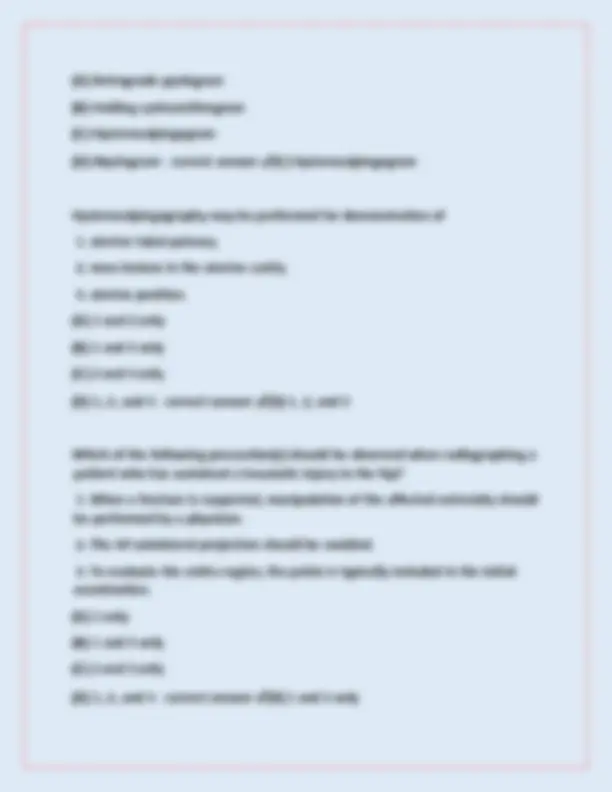
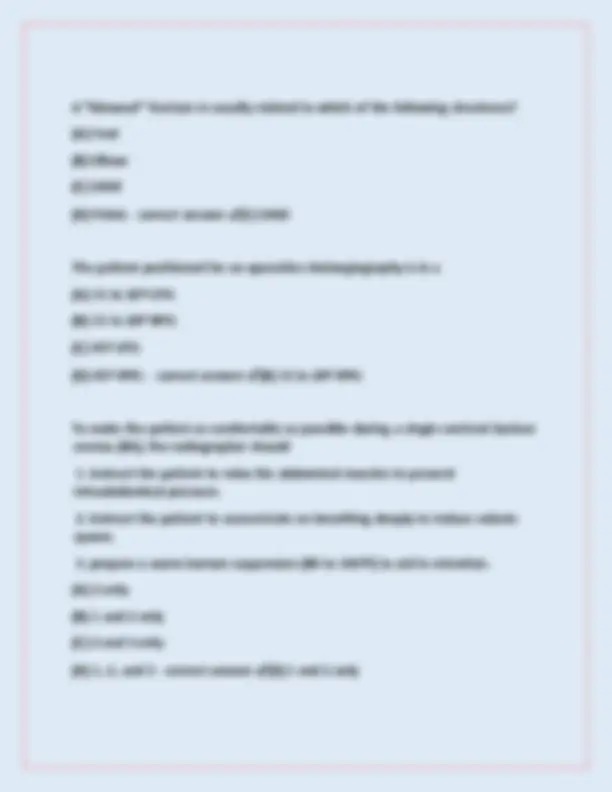

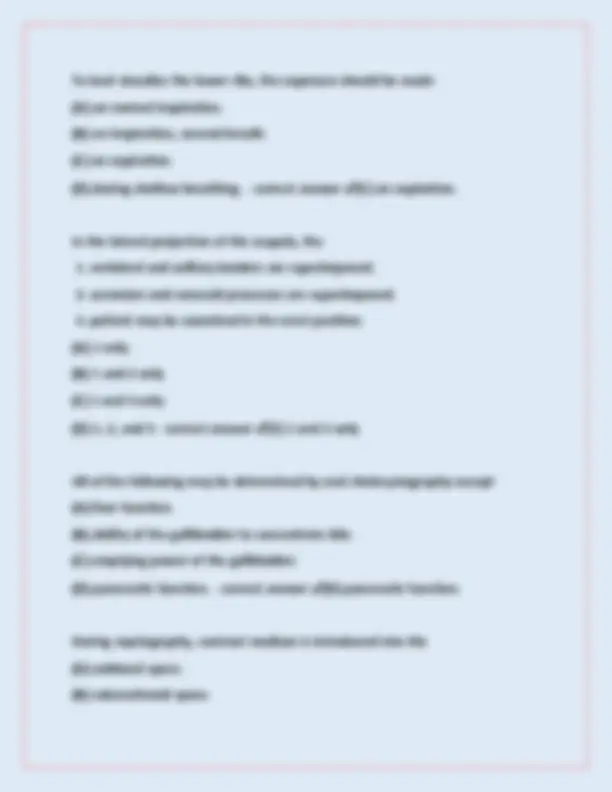
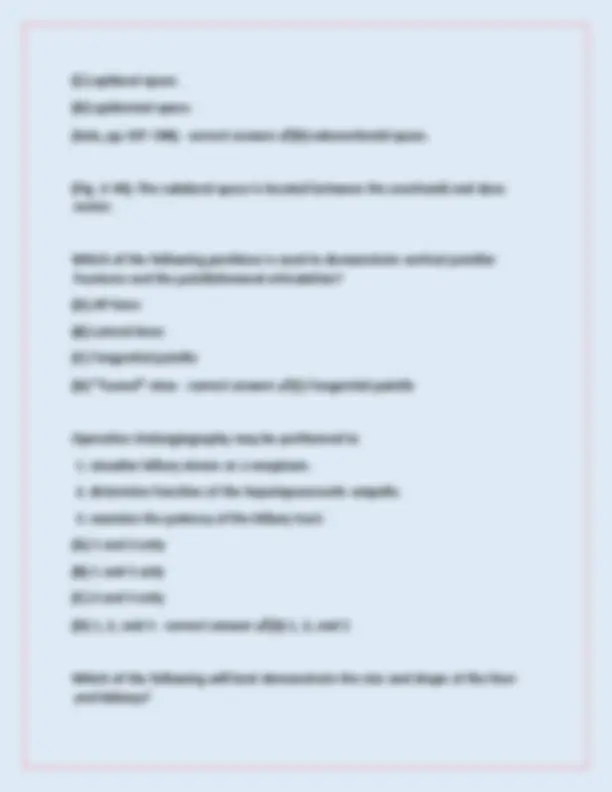
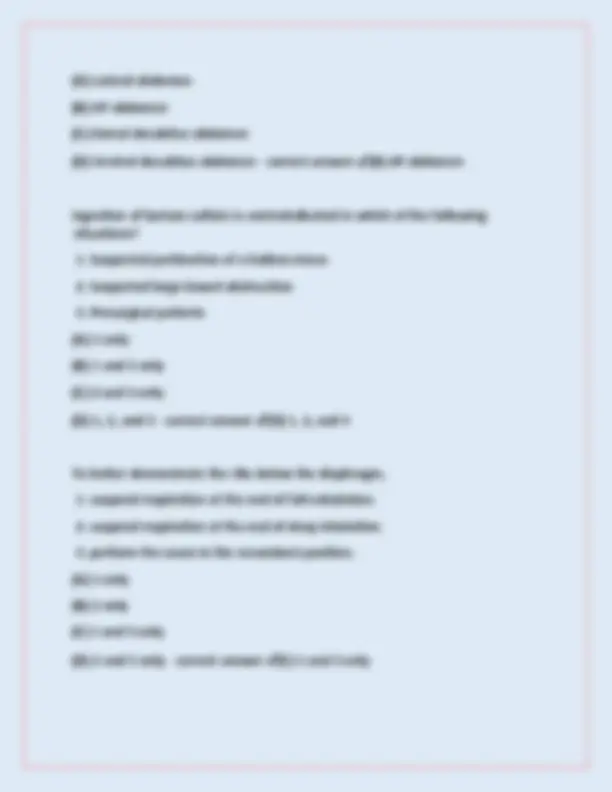

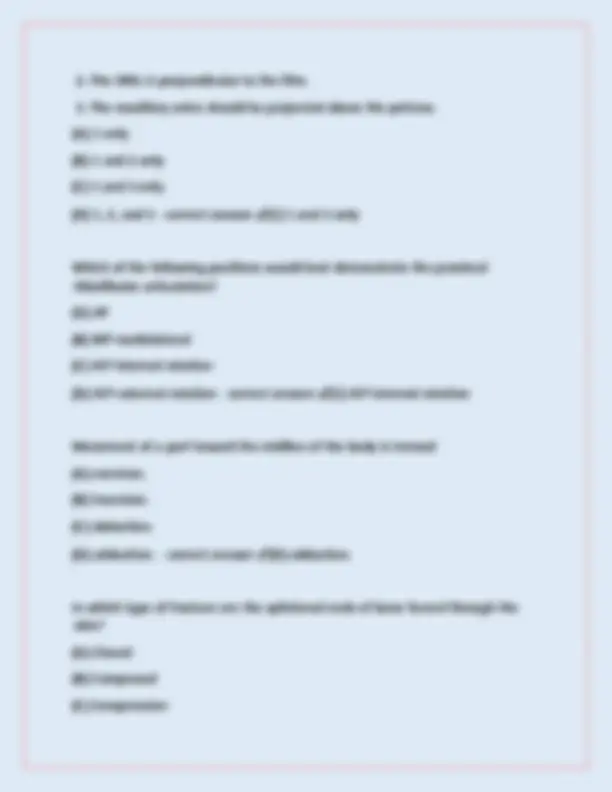
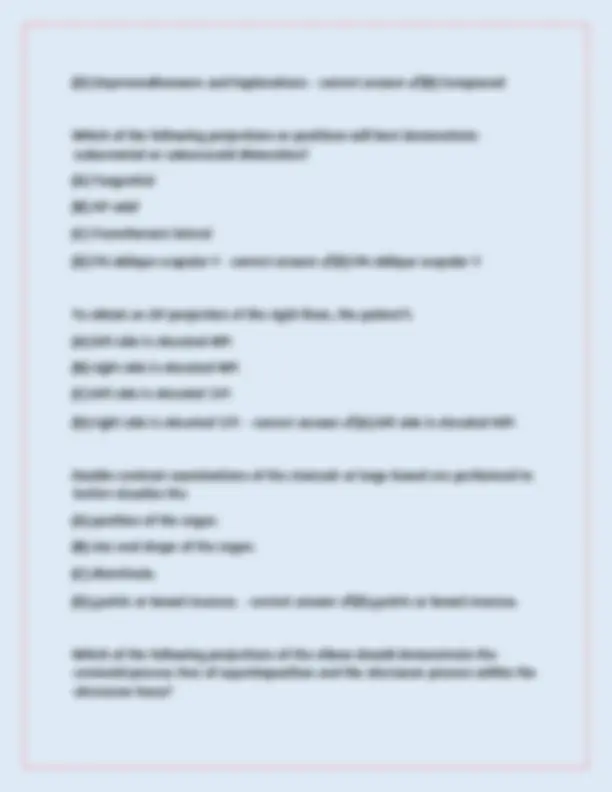
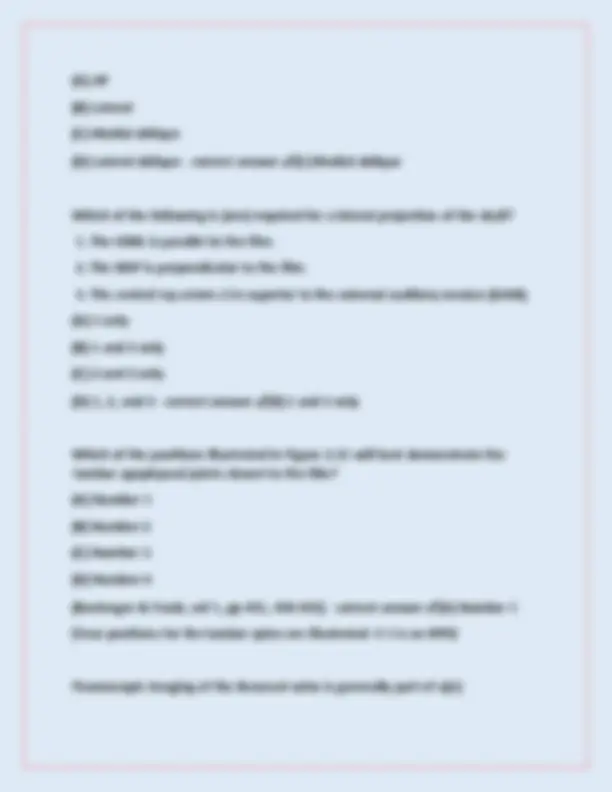
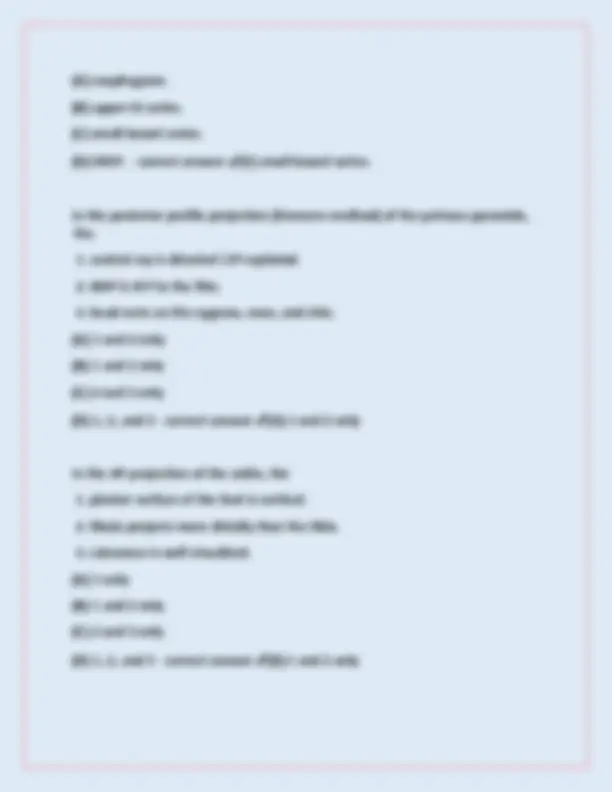
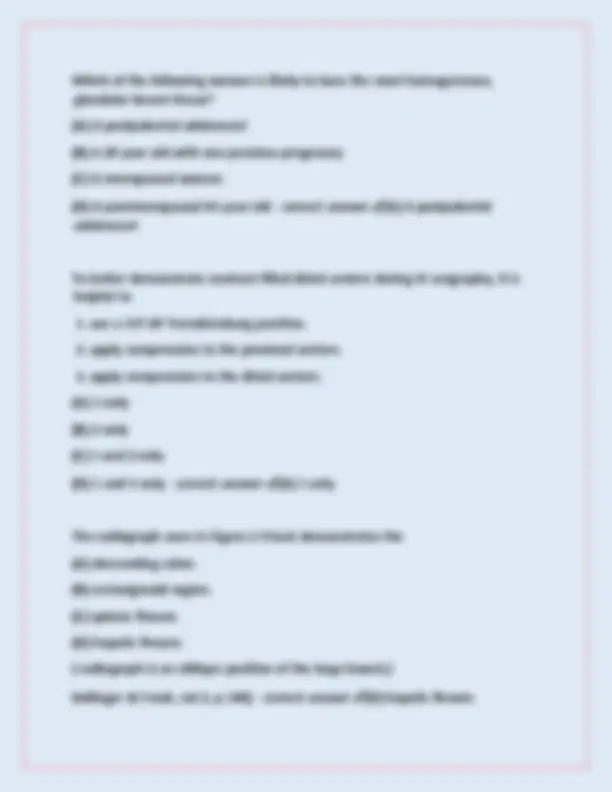
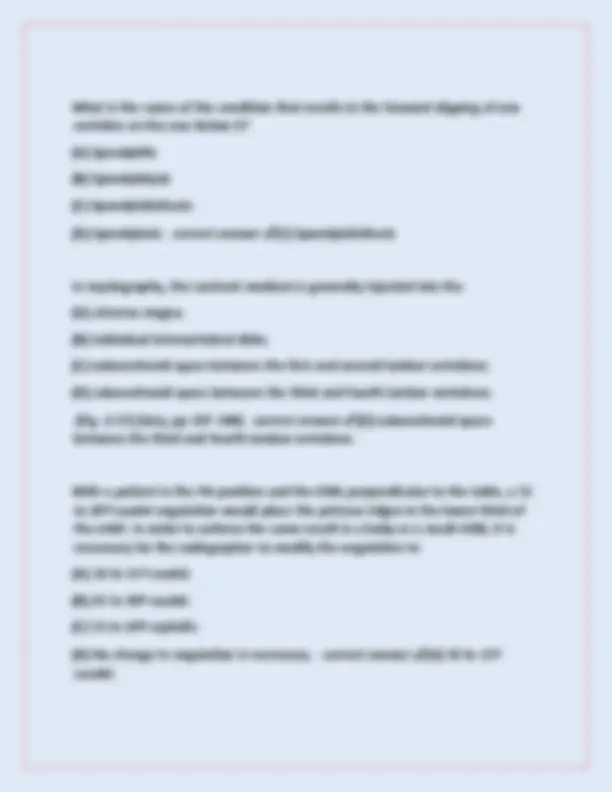

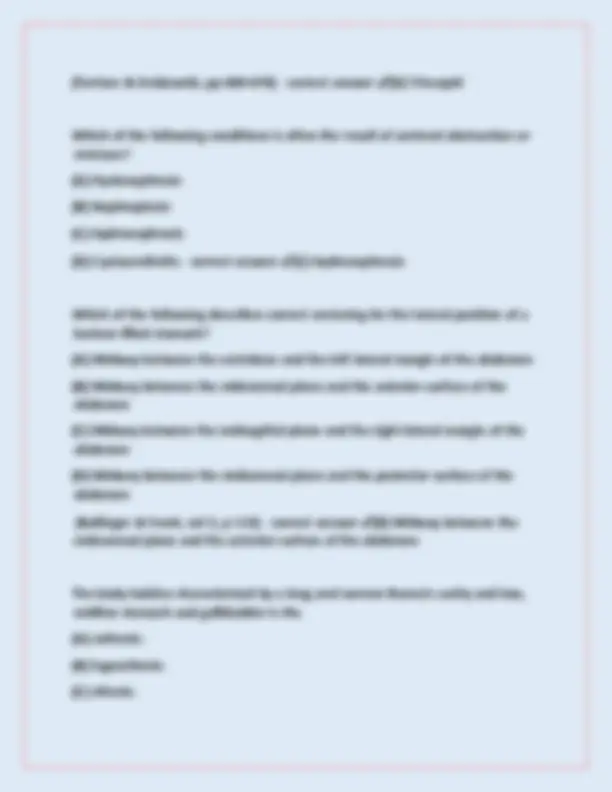



Study with the several resources on Docsity

Earn points by helping other students or get them with a premium plan


Prepare for your exams
Study with the several resources on Docsity

Earn points to download
Earn points by helping other students or get them with a premium plan
Community
Ask the community for help and clear up your study doubts
Discover the best universities in your country according to Docsity users
Free resources
Download our free guides on studying techniques, anxiety management strategies, and thesis advice from Docsity tutors
Radiology Exam Review [ARRT] – With verified answers
Typology: Exams
1 / 66

This page cannot be seen from the preview
Don't miss anything!



























































Which |of |the |following |positions |will |provide |an |AP |projection |of |the |L5-S |interspace? (A) |Patient |AP |with | 30 |to |35º |angle |cephalad (B) |Patient |AP |with | 30 |to |35º |angle |caudad (C) |Patient |AP |with |0º |angle (D) |Patient |lateral, |coned |to |L5 |- |correct |answer |✔(A) |Patient |AP |with | 30 |to |35º |angle |cephalad Which |of |the |following |anatomic |structures |is |indicated |by |the |number | 2 |in |Figure |2-7? (A) |Talus (B) |Medial |malleolus (C) |Lateral |malleolus (D) |Lateral |tibial |condyle (Cornuelle |& |Gronefeld, |pp |193-195) |- |correct |answer |✔(B) |Medial |malleolus The |four |major |arteries |supplying |the |brain |include |the |1. |brachiocephalic |artery. |2. |common |carotid |arteries. |3. |vertebral |arteries. (A) | 1 |and | 2 |only
(B) | 1 |and | 3 |only (C) | 2 |and | 3 |only (D) |1, |2, |and | 3 |- |correct |answer |✔(C) | 2 |and | 3 |only What |process |is |best |seen |using |a |perpendicular |CR |with |the |elbow |in |acute |flexion |and |with |the |posterior |aspect |of |the |humerus |adjacent |to |the |image |recorder? (A) |Coracoid (B) |Coronoid (C) |Olecranon (D) |Glenoid |- |correct |answer |✔(C) |Olecranon What |are |the |positions |most |commonly |employed |for |a |radiographic |examination |of |the |sternum? |1. |Lateral |2. |RAO |3. |LAO (A) | 1 |and | 2 |only (B) | 1 |and | 3 |only (C) | 2 |and | 3 |only (D) |1, |2, |and | 3 |- |correct |answer |✔(A) | 1 |and | 2 |only Which |of |the |positions |illustrated |in |Figure |2-1 |should |be |used |to |demonstrate |the |cervical |apophyseal |articulations? |1. |A
During |chest |radiography, |the |act |of |inspiration |1. |elevates |the |diaphragm. |2. |raises |the |ribs. |3. |depresses |the |abdominal |viscera. (A) | 1 |only (B) | 1 |and | 2 |only (C) | 2 |and | 3 |only (D) |1, |2, |and | 3 |- |correct |answer |✔(C) | 2 |and | 3 |only Standard |radiographic |protocols |may |be |reduced |to |include |two |views, |at |right |angles |to |each |other, |in |which |of |the |following |situations? (A) |Barium |examinations (B) |Spine |radiography (C) |Skull |radiography (D) |Emergency |and |trauma |radiography |- |correct |answer |✔(D) |Emergency |and |trauma |radiography Which |of |the |localization |lines |seen |in |Figure |2-35 |is |used |for |the |SMV |(Schüller |method) |projection |of |the |skull? (A) |Line | 1 (B) |Line | 2 (C) |Line | 3 (D) |Line | 4 (Saia, |p |144) |- |correct |answer |✔(C) |Line | 3
#3 |is |the |infraorbitomeatal |line |(IOML) Which |of |the |following |projections |of |the |abdomen |may |be |used |to |demonstrate |air |or |fluid |levels? |1. |Dorsal |decubitus |2. |Lateral |decubitus |3. |AP |Trendelenburg (A) | 1 |only (B) | 1 |and | 2 |only (C) | 1 |and | 3 |only (D) |1, |2, |and | 3 |- |correct |answer |✔(B) | 1 |and | 2 |only Blowout |fractures |of |the |orbit |are |best |demonstrated |using |the (A) |lateral |projection |of |the |facial |bones. (B) |parietoacanthial |projection |(Waters' |method). (C) |posteroanterior |projection |with |a |15º |caudal |angle. (D) |Sweet's |localization |method. |- |correct |answer |✔(B) |parietoacanthial |projection |(Waters' |method). Which |of |the |following |positions |demonstrates |all |the |paranasal |sinuses? (A) |Parietoacanthial (B) |PA |axial (C) |Lateral (D) |True |PA |- |correct |answer |✔(C) |Lateral
(Ballinger |& |Frank, |vol |1, |p |496) |- |correct |answer |✔(B) |complete |or |incomplete |rotator |cuff |tears. The |position |illustrated |in |the |radiograph |in |Figure |2-26 |may |be |obtained |with |the |patient |1. |supine |and |the |central |ray |angled |30º |caudad. |2. |supine |and |the |central |ray |angled |30º |cephalad. |3. |prone |and |the |central |ray |angled |30º |cephalad. (A) | 1 |only (B) | 2 |only (C) | 1 |and | 3 |only (D) | 2 |and | 3 |only |(Ballinger |& |Frank, |vol |2, |pp |134, |139) |- |correct |answer |✔(B) | 2 |only Which |of |the |following |is |demonstrated |in |a |25º |RPO |position |with |the |central |ray |entering | 1 |in |medial |to |the |elevated |ASIS? (A) |Left |sacroiliac |joint (B) |Right |sacroiliac |joint (C) |Left |ilium (D) |Right |ilium |- |correct |answer |✔(A) |Left |sacroiliac |joint In |the |posterior |oblique |position |of |the |cervical |spine, |the |intervertebral |foramina |that |are |best |seen |are |those (A) |nearest |the |film. (B) |furthest |from |the |film.
(C) |seen |medially. (D) |seen |inferiorly. |- |correct |answer |✔(B) |furthest |from |the |film. The |junction |of |the |transverse |colon |and |the |descending |colon |forms |the (A) |hepatic |flexure. (B) |splenic |flexure. (C) |transverse |flexure. (D) |sigmoid |flexure. (Ballinger |& |Frank, |vol |2, |p |89) |- |correct |answer |✔(B) |splenic |flexure. In |order |to |better |demonstrate |the |mandibular |rami |in |the |PA |position, |the (A) |skull |is |obliqued |toward |the |affected |side. (B) |skull |is |obliqued |away |from |the |affected |side. (C) |central |ray |is |angled |cephalad. (D) |central |ray |is |angled |caudad. |- |correct |answer |✔(C) |central |ray |is |angled |cephalad. Inspiration |and |expiration |projections |of |the |chest |may |be |performed |to |demonstrate |1. |pneumothorax. |2. |foreign |body. |3. |atelectasis. (A) | 1 |only (B) | 1 |and | 2 |only (C) | 1 |and | 3 |only
|2. |MSP |parallel |to |the |tabletop |3. |15º |caudad |angulation (A) | 1 |only (B) | 2 |only (C) | 1 |and | 2 |only (D) | 2 |and | 3 |only |- |correct |answer |✔(D) | 2 |and | 3 |only Which |of |the |following |can |be |used |to |demonstrate |the |intercondyloid |fossa? |1. |Patient |PA, |knee |flexed |40º, |central |ray |directed |caudad |40º |to |the |popliteal |fossa |2. |Patient |AP, |cassette |under |flexed |knee, |central |ray |directed |cephalad |to |knee, |perpendicular |to |tibia |3. |Patient |PA, |patella |parallel |to |film, |heel |rotated | 5 |to |10º |lateral, |central |ray |perpendicular |to |knee |joint (A) | 1 |only (B) | 1 |and | 2 |only (C) | 2 |and | 3 |only (D) |1, |2, |and | 3 |- |correct |answer |✔(B) | 1 |and | 2 |only Knee |arthrography |may |be |performed |to |demonstrate |a |1. |torn |meniscus. |2. |Baker's |cyst. |3. |torn |rotator |cuff. (A) | 1 |and | 2 |only
(B) | 1 |and | 3 |only (C) | 2 |and | 3 |only (D) |1, |2, |and | 3 |- |correct |answer |✔(A) | 1 |and | 2 |only Which |of |the |following |articulations |may |be |described |as |diarthrotic? |1. |Knee |2. |Intervertebral |joints |3. |Temporomandibular |joint |(TMJ) (A) | 1 |only (B) | 2 |only (C) | 1 |and | 3 |only (D) |1, |2, |and | 3 |- |correct |answer |✔(C) | 1 |and | 3 |only Which |of |the |following |statements |are |true |regarding |Figure |2-28? |1. |The |radiograph |was |made |in |the |RAO |position. |2. |The |central |ray |should |enter |more |inferiorly. |3. |The |sternum |should |be |projected |onto |the |right |side |of |the |thorax. (A) | 1 |and | 2 |only (B) | 1 |and | 3 |only (C) | 2 |and | 3 |only (D) |1, |2, |and | 3 (Ballinger |& |Frank, |vol |1, |pp |274-277) |- |correct |answer |✔(A) | 1 |and | 2 |only
AP |stress |studies |of |the |ankle |may |be |performed |1. |to |demonstrate |fractures |of |the |distal |tibia |and |fibula. |2. |following |inversion |or |eversion |injuries. |3. |to |demonstrate |a |ligament |tear. (A) | 1 |only (B) | 1 |and | 2 |only (C) | 2 |and | 3 |only (D) |1, |2, |and | 3 |- |correct |answer |✔(C) | 2 |and | 3 |only In |the |AP |axial |projection |(Towne |method) |of |the |skull, |with |the |central |ray |directed |30º |caudad |to |the |orbitomeatal |line |(OML) |and |passing |midway |between |the |external |auditory |meatus, |which |of |the |following |is |best |demonstrated? (A) |Occipital |bone (B) |Frontal |bone (C) |Facial |bones (D) |Basal |foramina (Fig. |2-40) | (Ballinger |& |Frank, |vol |2, |p |270) |- |correct |answer |✔(A) |Occipital |bone Lateral |deviation |of |the |nasal |septum |may |be |best |demonstrated |in |the (A) |lateral |projection. (B) |PA |axial |(Caldwell |method) |projection. (C) |parietoacanthial |(Waters' |method) |projection.
(D) |AP |axial |(Grashey |/ |Towne |method) |projection. |- |correct |answer |✔(C) |parietoacanthial |(Waters' |method) |projection. Which |of |the |following |structures |is |(are) |located |in |the |LUQ? |1. |Stomach |2. |Spleen |3. |Cecum (A) | 1 |only (B) | 2 |only (C) | 1 |and | 2 |only (D) |1, |2, |and | 3 |- |correct |answer |✔(C) | 1 |and | 2 |only Which |of |the |following |equipment |is |necessary |for |ERCP? |1. |A |fluoroscopic |unit |with |spot |film |and |tilt |table |capabilities |2. |A |fiberoptic |endoscope |3. |Polyethylene |catheters (A) | 1 |and | 2 |only (B) | 1 |and | 3 |only (C) | 2 |and | 3 |only (D) |1, |2, |and | 3 |- |correct |answer |✔(D) |1, |2, |and | 3 Which |of |the |following |criteria |is |(are) |required |for |visualization |of |the |greater |tubercle |in |profile? |1. |Epicondyles |parallel |to |the |film |2. |Arm |in |external |rotation
(A) |lateral |rectum. (B) |AP |axial |rectosigmoid. (C) |right |and |left |lateral |decubitus |abdomen. (D) |RAO |and |LAO |abdomen. |- |correct |answer |✔(C) |right |and |left |lateral |decubitus |abdomen. Which |of |the |following |are |demonstrated |in |the |oblique |position |of |the |cervical |spine? |1. |Intervertebral |foramina |2. |Apophyseal |joints |3. |Intervertebral |joints (A) | 1 |only (B) | 1 |and | 2 |only (C) | 2 |and | 3 |only (D) |1, |2, |and | 3 |- |correct |answer |✔(A) | 1 |only The |AP |axial |projection, |or |"frog |leg" |position, |of |the |femoral |neck |places |the |patient |in |a |supine |position |with |the |affected |thigh (A) |adducted |25º |from |the |horizontal. (B) |abducted |25º |from |the |vertical. (C) |adducted |40º |from |the |horizontal. (D) |abducted |40º |from |the |vertical. |- |correct |answer |✔(D) |abducted |40º |from |the |vertical. The |AP |Trendelenburg |position |is |often |used |during |an |upper |GI |examination |to |demonstrate
(A) |the |duodenal |loop. (B) |filling |of |the |duodenal |bulb. (C) |hiatal |hernia. (D) |hypertrophic |pyloric |stenosis. |- |correct |answer |✔(C) |hiatal |hernia. The |advantages |of |digital |subtraction |angiography |over |film |angiography |include |1. |greater |contrast |medium |sensitivity. |2. |immediately |available |images. |3. |increased |resolution. (A) | 1 |only (B) | 1 |and | 2 |only (C) | 2 |and | 3 |only (D) |1, |2, |and | 3 |- |correct |answer |✔(B) | 1 |and | 2 |only Which |of |the |following |statements |is |(are) |true |regarding |lower-extremity |venography? |1. |The |patient |is |often |examined |in |the |semierect |position. |2. |Contrast |medium |is |injected |through |a |vein |in |the |foot. |3. |Filming |begins |at |the |hip |and |proceeds |inferiorly. (A) | 1 |only (B) | 1 |and | 2 |only (C) | 1 |and | 3 |only (D) |1, |2, |and | 3 |- |correct |answer |✔(B) | 1 |and | 2 |only
(B) | 1 |and | 3 |only (C) | 2 |and | 3 |only (D) | 3 |only (Fig. |2-55) |(Ballinger |& |Frank, |vol |1, |p |228) |- |correct |answer |✔(B) | 1 |and | 3 |only To |better |visualize |the |knee |joint |space |in |the |radiograph |in |Figure |2-29, |the |radiographer |should (A) |flex |the |knee |more |acutely. (B) |flex |the |knee |less |acutely. (C) |angle |the |CR | 5 |to |7º |cephalad. (D) |angle |the |CR | 5 |to |7º |caudad. |(Ballinger |& |Frank, |vol |1, |p |293) |- |correct |answer |✔(C) |angle |the |CR | 5 |to |7º |cephalad. Which |of |the |following |examinations |require(s) |special |identification |markers |in |addition |to |the |usual |patient |name |and |number, |date, |and |side |marker? |1. |IVP |2. |Tomography |3. |Abdominal |survey (A) | 1 |only (B) | 1 |and | 2 |only (C) | 2 |and | 3 |only (D) |1, |2, |and | 3 |- |correct |answer |✔(D) |1, |2, |and | 3
Which |of |the |following |is |a |condition |in |which |an |occluded |blood |vessel |stops |blood |flow |to |a |portion |of |the |lungs? (A) |Pneumothorax (B) |Atelectasis (C) |Pulmonary |embolism (D) |Hypoxia |- |correct |answer |✔(C) |Pulmonary |embolism In |which |projection |of |the |foot |are |the |sinus |tarsi, |cuboid, |and |tuberosity |of |the |fifth |metatarsal |best |demonstrated? (A) |Lateral |oblique |foot (B) |Medial |oblique |foot (C) |Lateral |foot (D) |Weight-bearing |foot |- |correct |answer |✔(B) |Medial |oblique |foot Which |of |the |following |are |part |of |the |bony |thorax? |1. | 12 |thoracic |vertebrae |2. |Scapulae |3. | 24 |ribs (A) | 1 |only (B) | 1 |and | 2 |only (C) | 1 |and | 3 |only (D) |1, |2, |and | 3 (Bontrager, |p |336) |- |correct |answer |✔(C) | 1 |and | 3 |only In |which |of |the |following |positions |was |the |radiograph |in |Figure |2-9 |taken?